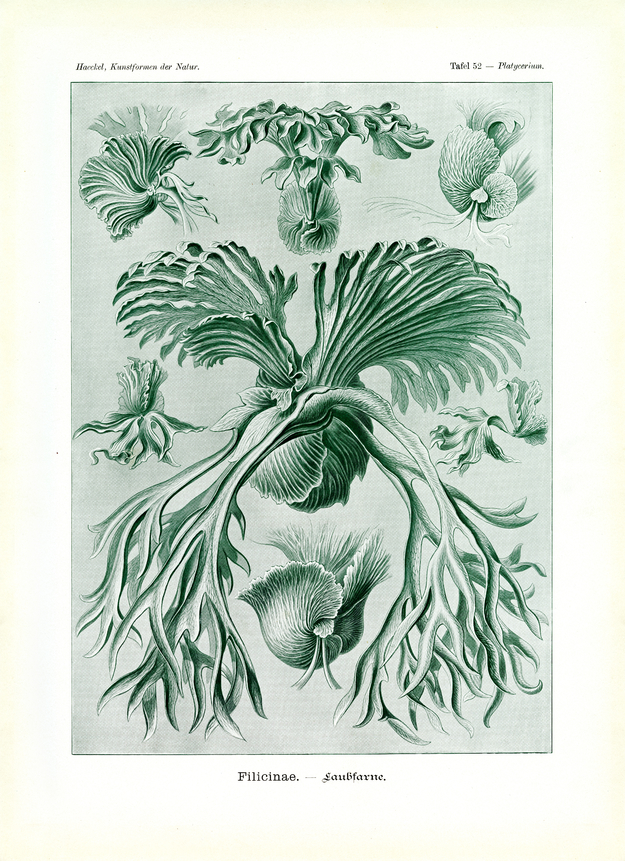Translation of the original German introduction by Ernst Haeckel:
Division of Diaphyta or Achegoniata (Vorkeimpflanzen); - main class of Pteridophyta (Farnpflanzen); - class of Filicinae (Laubfarne); - family of Polypo diaceae (Tüpfelfarne).
In countries of temperate zones the highly variable class of Filicinae or Filicariae (Laubfarne) is present only in small, tender ferns. In the tropical areas, however, these plants play a much more decisive role with impressive fern trees forming a superb and beautiful part of the jungles, or as considerable ‘pseudo parasites’ or Epiphytae covering the branches and trunks of many trees. Among these Epiphytae the ‘staghorn-fern’ (Platycerium) stands out with its strikingly decorative appearance. It is found in ‘Insulinde’ and other tropical countries in huge amounts not only in trees of the jungle but also as ornamental plant in gardens. The peculiar form of Plactycerium is conditioned by the division of tasks or the ergonomics of its leaves or “frond”. In most of the local ferns they are of the same formation; tender green, pinnate or multipartite leaves with small brown ‘piles of fruit’ (Sori) developed on the bottom side, composed of numerous ‘spore capsules’ (Sporangia); microscopically small cells contained inside these are asexual germ cells (Sporae). Among the Platycerium, however, as in some other ferns, the plant develops two or even three different kind of fronds; one of these, the foliage, nurtures the plant only and doesn’t form spores; the other, spore gills, produce the spores required for reproduction; the third form, ‘niche leaves’ or ‘mantle leaves’ form a niche at the base of the fern in which the dying off plant residues collect and produce humus. Roots of the fern grow into this fertile humus and receive nutrition out of it. With pale green and yellow ‘niche leaves’ dying back soon and new ones forming on top of them, thick brown cushions develop, frequently of a diameter of half a meter and more. Green foliage, in contrast, hangs down from these cushions in the shape of multipartite fronds reaching a length of up to several meters; usually they are divided like multiple fork teeth, or like a deer’s or elk’s antlers (Platycerium alcicorne). Spore capsules develop on the bottom side of the fronds, at times at the base of individual leaves only, at times on the large area of the lower leave, at times at the tips of the fork-like branches.
Translation by VR Translators Bangalore
We've scanned the original lithography at 1200dpi on the Epson A3 scanner of A3 scanner huren. You can download a 400dpi JPEG here.
